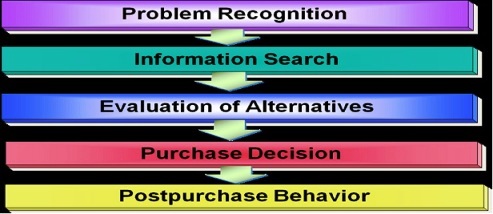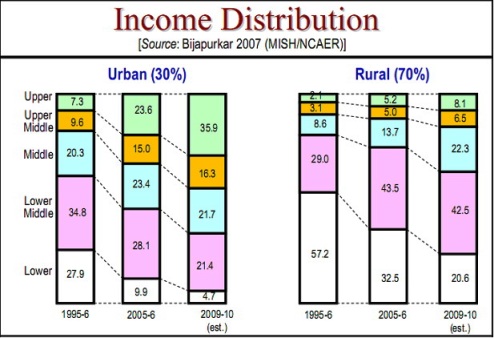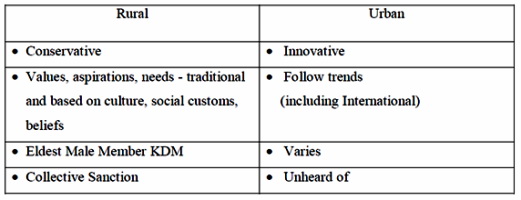MORE FREE TERM PAPERS MARKETING:
|
||||||||
CHANGES IN CONSUMER BEHAVIOR
AND THEIR IMPLICATIONS ON MARKETERS
 India
has the youngest population profile among the numerically significant
countries - there are a lot of young people in different income segments
and locations, who are influencing their parents’ spending or spending
their own money.
India
has the youngest population profile among the numerically significant
countries - there are a lot of young people in different income segments
and locations, who are influencing their parents’ spending or spending
their own money.
Possibly the most challenging concept in the marketing is to deal with
understanding the buyer behaviour. The attitude of Indian consumers
has undergone a major transformation over the last few years. The Indian
consumer today wants to lead a life full of luxury and comfort. He wants
to live in present and does not believe in savings for the future. An
important and recent development in Indias consumerism is the emergence
of the rural market for several basic consumer goods. The Indian middle
class has provided a big boost to the consumer culture during the recent
past and it is hoped that their buying behaviour will continue to change
in the coming future. Due to fast growth of the services sector per
capita income of people of India is also increasing. The number of middle
class is increasing due to another fact that people are fast shifting
from agriculture to the services and industry sector where growth prospects
are reasonably high as compared to the agriculture sector which is showing
slow growth.
The consumption pattern of a country depends on liberalization of economic
policies, buying habits of the younger generation, financial independence
at a young age, increase in number of nuclear families and increase
in media exposure of the people. The tastes and preferences of the current
generation are changing rapidly. The current generation does not mind
paying extra for better facilities and ambience. Another major factor
that has led to increased consumerism is the growth of credit culture
in India. The Indian consumer does not feel shy to purchase products
on credit and pay tomorrow for what they use or buy today. This tendency
has led to a tremendous increase in purchase of homes, cars, two-wheelers
and consumer goods. The market for luxury products in India is also
climbing at an astonishing rate as compared to a decade ago when it
was almost negligible. The reason behind this is that the purchasing
power of people of India is rising very steeply. The Indian consumer
today is highly aware about the product, price, quality and the options
available with him. The purchasing is done by keeping all these factors
in mind. Today, price is not the only consideration as it was a few
years back when prices played a major role in purchasing. Marketers
are trying hard to capture this ever increasing Indian middle class
as they form the bulk of Indian consumers.
FACTORS AFFECTING CONSUMER BEHAVIOR
Consumer behaviour is affected by a lot of variables, ranging from personal motivations, needs, attitudes and values, personality characteristics, socio-economic and cultural background, age, sex, professional status to social influences of various kinds exerted by family, friends, colleagues and society as a whole. The combinations of these various factors produce a different impact on each one of us as manifested in our different behavior as consumers. The various factors that affect buying behavior of in rural India are:
1. Environment of the consumer - The environment or the surroundings, within which the consumer lives, has a very strong influence on the buyer behaviour, egs. Electrification, water supply affects demand for durables.
2. Geographic influences - The geographic location in which the consumer is located also speaks about the thought process of the consumer. For instance, villages in South India accept technology quicker than in other parts of India. Thus, HMT sells more winding watches in the north while they sell more quartz watches down south.
3. Influence of occupation – The land owners and service clan buy more of Category II and Category III durables than agricultural labourers/farmers.
4. Place of purchase - (60% prefer HAATS due to better quality, variety & price) Companies need to assess the influence of retailers on both consumers at village shops and at haats.
5. Creative use of product – Example- Godrej hair dye being used as a paint to colour horns of oxen, Washing machine being used for churning lassi. The study of product end provides indicators to the company on the need for education and also for new product ideas.
Cultural factors Influencing Consumer Behaviour
Today’s consumers strictly follow their culture, tradition
and values, as a result of which foreign companies were forced to give
an Indian touch to them in order to succeed in India. McDonalds, MTV,
Pepsi, Star TV, Coca Cola India and many more had to Indianise themselves
to flourish in India.
Cultural factors exert the broadest and deepest influence on consumer
behaviour. The marketer needs to understand the role played by the buyer's
culture. Culture is the most basic element that shapes a person’s wants
and behaviour. In India, there are so many different cultures, which
only goes on to make the marketer's job tougher. Some of the few cultural
factors that influence buyer behaviour are:
1. Product (colour, size, design, and shape):
There are many examples that support this point. For example, the Tata
Sumo, which was launched in rural India in a white colour, was not well
accepted. But however, when the same Sumo was re-launched as Spacio
(a different name) and in a bright yellow colour, with a larger seating
capacity and ability to transport good, the acceptance was higher.
Another good example would be Philips audio systems. Urban India looks
at technology with the viewpoint of „the smaller the better. However,
in rural India, the viewpoint is totally opposite. That is the main
reason for the large acceptance of big audio systems. Thus Philips makes
audio systems, which are big in size and get accepted in rural India
by their sheer size.
2. Social practices: There are so many different cultures, and each culture exhibits different social practices. For example, in a few villages they have common bath areas. Villagers used to buy one Lifebuoy cake and cut it into smaller bars. This helped lifebuoy to introduce smaller 75-gram soap bars, which could be used individually.
3. Decision-making by male head: The male in Indian culture has always been given the designation of key decision maker. For example, the Mukhiya’s opinion (Head of the village), in most cases, is shared with the rest of the village. Even in a house the male head is the final decision maker. In rural areas, this trend is very prominent.
4. Changes in saving and investment patterns: From Gold, Land, to Tractors, VCR’s, LCD TV’s etc.
Consumer’s decision making process

DIFFERENT SEGMENTS OF INDIAN MARKET
The Socialites :
Socialites belong to the upper class. They prefer to shop in specialty
stores, go to clubs on weekends, and spend a good amount on luxury goods.
They are always looking for something different. They go for high value,
exclusive products. Socialites are also very branding conscious and
would go only for the best known in the market.
The conservatives :
The Conservatives belong to the middle class. The conservative segment
is the reflection of the true Indian culture. They are traditional in
their outlook, cautious in their approach towards purchase; spend more
time with family than in partying and focus more on savings than spending.
Slow in decision making, they seek a lot of information before making
any purchase. They look for durability and functionality but at the
same time is also image conscious.
The working women:
The working woman segment is the one, which has seen a tremendous growth in the late nineties. This segment has opened the floodgates for the Indian retailers. The working woman today has grown out of her long-standing image of being the homemaker. Today, she is rubbing shoulders with men, proving herself to be equally good, if not better. Working women have their own mind in decision to purchase the products that appeal to them.
Youth segments:
The rise of generation next has been written about with unbridled optimism and enthusiasm, based on the coming of age of liberalization children. They are global in their worldwide view and have been exposed to enormous information unlike their parents, raised amidst a consumption-friendly and consumption encouraging social discourse. They are expected to be at the forefront of creating a new, modern, west-embracing consumer society, as well as yield the demographic dividend that will drive economic growth.
THE NEW INDIAN CONSUMER MARKET STRUCTURE:
There are five types of consumer groups based on what they consume and created a framework:
The Rich: - The rich who have most of the luxury goods like cars, PCs, air conditioners and are generally the consumers of premium products.
The Consuming Class: - Consumers which have 70 percent of the „utility‟ durables like two wheeler, refrigerators, washing machines and the bulk of regular FMCGs.
The Climbers: - Consumers which have at least one major durable in their homes – either a mixer or a sewing machine or perhaps a television set. They are main consumer of population segment consumer goods.
The Aspirants: - Consumers who are just
entering consumption and have the very basics
Goods like a watch, a bicycle, a radio, or a table fan.
The Destitute: - Consumers who own and consume practically nothing, living as they do from hand to mouth.
Income distribution of Indian Population in rural and urban areas:

According to a report released by the Commerce Department, outlays of
televisions, computers, video and telephone equipment grew by 1.8% in
the first six months of 2010, compared to the first half of pre-recession
2007. In comparison, during the same time periods, sales of appliances
decreased by 3.6% and that of furniture declined by a whopping 11%,
indicating that consumer trends are shifting. The report also indicated
that overall consumer spending remained flat in June from the previous
month and U.S. personal savings as a percentage of disposable income
rose 6.4% from a month earlier.
This data indicates that consumers are unsure of the overall health
of the economy and are stashing away extra cash for a rainy day, but
are still willing to splurge on a new iPhone, Blu-ray video player,
computer or flat screen television. Additionally, it illustrates changes
in consumer trends: people are staying home more often and bringing
entertainment in-house and, regardless of economic health, consumers
want the newest and best gadgets on the market.
Rural consumer of India:
Rural Consumers majorly look into the value that the product offers. They associate value with the Benefits that the product offers, its availability, and its Cost. When talking of benefits, they look at the features of the product as well as the Packaging and attractiveness, availability, whether or not the products are available at Retail Shops and Haats, cost, whether or not the product is reasonably priced.
The Differences in Buyer Behavior:

TODAY’S CONSUMER
The Indian consumers of today are unique in the following aspects:
1) Indian consumers have become value sensitive and are not much price sensitive as was the case earlier. If they feel that a particular product offers them more value and its price is high, even then they are willing to buy the product.
2) The Indian consumers strictly follow their culture, tradition and values, as a result of which foreign companies were forced to give an Indian touch to them in order to succeed in India. McDonalds, MTV, Pepsi, Star TV, Coca Cola India and many more had to Indianise themselves to flourish in India. Karva Chauth is celebrated with more zeal and enthusiasm than the Valentine Day.
3) The Indian consumer of today gives preference to features of a product rather than its brand name. The trend that higher segment consumers only buy the top brands has also come to an end. 4) Even after liberalization Indian companies and brands are doing very well. It is clearly evident from the fact that despite many foreign brands being sold in India, Raymond is still India‟s largest textile company and Haldiram is doing well despite the presence of McDonalds and Pizza Hut.
5) The consumers today are not confined to a single brand and prefer change rather than sticking to the same brand. Not often do we see any home with cars of the same brand or household products of the same brand.
6) The use of credit card for shopping is a new emerging
trend in India. Also consumers are
availing credit or loan from banks and other financial institutions
to fulfil their needs and wants.
7) The Indian consumers have shown another major change in their buying behaviour. They just don‟t want availability of products; they also want better experience, services and ambience. This has led to the growth of shopping malls where a shopping, entertainment and better facility is all available under one roof.
8) The rural Indian consumers are also showing signs of change. They have all the modern amenities at their home and their standard of living is fast improving. The rural households have earned huge money due to price rise in real estate. They are also shifting towards industrial and services sector; hence their purchasing power is increasing. It is reflected in their living standard and possession of all electronic gadgets and luxury cars.
9) There is a stiff competition in the Indian market today and it has become a buyer‟s market from seller‟s market. Customers are the ultimate beneficiary of the fierce competition in the market. Competition has reduced prices to a great extent and has forced the manufacturer to maintain product quality to sustain in the highly competitive market.
Change at a glance:
Many remarkable changes have taken place in Indian consumer buying behaviour over the last five years. Some of them are:
1) Television penetration rose to 50% of total population in 2005 as compared to 35% in 2000.
2) Refrigerator penetration rose to 12% in 2005 as compared to 9.4% in 2000.
3) 12% of total population had telephone connections in 2005 as compared to 6.5% in 2000.
4) Average age of home owners has come down to 28-30 years in 2005 as compared to 40 years in 2000.
5) Number of mobile users in India is 130 million and number of internet users is 40 million.
6) Credit card penetration has grown to 10 times between 2001 and 2005.
7) Indian consumers now prefer multiplexes as compared to traditional cinema halls, although multiplexes are costlier than traditional cinema halls.
8) The tastes and preferences of consumers are changing. Consumers today prefer luxury products like expensive watches, sun glasses, mobile phones, antique jewellery, etc.
9) Consumers are shifting focus towards LCD and plasma
TV from normal TV, laptop from PC, luxurious cars from small cars.
10) Consumers now want better hospitality and this has led to the growth
of tourism and hotel industry.
11) Customers of today also want better housing facilities. Due to this lot of builders and construction companies are blossoming and making good money and customers are receiving what they want.
Trendy Life style:
The current urban middle and upper class Indian consumer buying behaviour to a large extent has western influence. There is an increase in positive attitude towards western trends. The Indian consumer has become much more open-minded and experimental in his/her perspective. There is now an exponential growth of western trend reaching the Indian consumer by way of the media and Indians working abroad. Foreign brands have gained wide consumer acceptance in India, they include items such as:
- Beverages
- Packed food, Ready to eat food , Pre-cooked food, Canned food
- Personal care products
- Audio/video products
- Garment and apparel
- Footwear, Sportswear
- Toys and gift items
Change in marketing strategies of companies with change in consumer
buying behaviour
With change in consumer buying behavior the companies
also made necessary changes in their marketing strategies. The changes
include:
1) Launching of premium products by companies to fulfill requirements
of high class consumers.
2) Since purchasing power of rural India has increased, the companies
have started shifting their focus towards rural India to capture untapped
rural market. This has reaped huge benefits for companies like in cases
of PepsiCo, Coca Cola India and other FMCG companies.
3) Companies not only aim to sell their products but also aim to provide
better after sales services to its consumers. For example companies
have provisions to send their technicians to repair the cars struck
at highways or other outer locations due to technical failure or in
case of a mishap. This improves the company‟s credibility and helps
to build its customer base.
4) Companies design their products on the basis of market segmentation
so that they have products to suit every pocket and requirement.
5) Due to sharp growth in the communication sector, companies are providing
many schemes and plans to attract customers. For example mobile service
providers provide lifetime option and free calls to other mobile users
under a specific plan of the company.
6) Due to fierce competition in the electronics market and people‟s
willingness to purchase hi-tech products the rates of LCD and plasma
TVs have been slashed by 25%-30%. Through this strategy electronic companies
received very good response from the consumers in the recent past and
were able to build a considerable market for their products.
7) Indian consumers have developed a liking for foreign tours and holidays.
This has led to development of many travel agencies that provide a planned
foreign tour at a reasonable price. What is even more interesting is
that the customer does not have to pay the amount in lump sum; instead,
he has the facility to make the payment in monthly instalments according
to his convenience.
8) Consumers of India have developed a tendency to save travel time.
For such consumers low fare carriers are available that provide air
travel facility at a very affordable price.
9) Consumers of India want better housing facilities. The construction
companies are fulfilling this requirement of consumers by providing
them luxurious houses, exquisite interiors, round the clock water and
electricity supply, full time security, club house, gymnasium, etc.
within the premises.
10) Indian consumers are increasingly becoming aware of the importance
of health and hygiene. Hence companies are making products to suit their
health like low calorie, low fat food. As far as hygiene is concerned
companies have fully mechanized their plants to maintain hygiene and
pack the food in such a way that it remains fresh for longer period
of time and does not lose its nutritive value before consumption.
11) The need for internet is fast growing. To fulfil this need of consumers,
mobile manufacturing companies are providing internet access facility
on mobile phones. This has revolutionized the communication sector and
provided a means of communication that was never ever in anybody‟s dreams
till a few years back.
12) Indian consumer‟s liking for credit is also increasing rapidly.
Hence many financial institutions have come into existence in India
and are flourishing. Banks have also become liberal in their loan and
credit policies.
Online Marketing:
Currently, the products Indian consumers are buying through online are greeting cards, clothes, CDs/VCDs/DVDs, cassettes, books, magazines, medicine and educational material. The popular online shops in India include:
• www.ebay.in
• www.shopping.rediff.com
• www.reliablegreetings.com
• www.shopping.expomarkets.com
Celebrity Influence:
This is an important tool which is able to influence Indian consumer
buying behaviour. In India, celebrities are being increasingly used
in marketing communication by marketers to lend personality to their
products. Their activities and movements are being closely watched and
imitated. What they endorse sell like hot cakes. Indians always love
their heroes and heroines. Consumers like advertisements more if they
are admirers of the celebrities in the advertisements. When a consumer
likes the celebrity in the advertisement, he or she is more likely to
accept what the celebrity says about the advertised product and therefore
will develop more positive feelings toward the advertisement and the
brand itself. Famous celebrities are able to attract attention and retain
attention by their mere presence in the advertisements.
Eco-friendly Products:
The environmental awareness in India has started affecting marketing
of products based upon their eco-friendliness. In general, Indian consumers
are likely to buy environmentally responsible products and packs. The
future key for marketing could be to select more ethical and ecological
responsible products and packaging, which is also convenient for consumers,
thus, balancing environmental concerns with commercial considerations.
Consumers in India are taking lead in prompting manufacturers to adopt
technologies to produce eco-friendly products.
FUTURE TRENDS OF CONSUMER BEHAVIOR
Some emerging future trends of buying behavior of Indian consumers are:
1) The new generation will prefer brands that are launched during their growing up years. They will not prefer brands that are very old in the market. This will make it easier for new brands to cement their place in the market and run successfully.
2) The new generation will possess more risk taking capability and their previous generations. They will be willing to try out new careers, new ideas and new ways of doing things.
3) Indian consumers will be more logical in their thinking and foreign brands will not only be considered as the standard of quality. Each brand, be it Indian or foreign, will be judged on its merit.
4) The middle and lower class consumers buying behaviour will change and they may behave as if they are rich.
5) The contribution of women in decision making will increase with growing number of nuclear families, educated women and working women. The number of middle class working women will rise sharply. This will lead to introduction of women oriented products that may range from insurance products to vocational education.
6) Tomorrows consumer will focus more on technology and credit purchase.
7) Number of nuclear families will increase.
8) Health care will become very important in the coming years.
CONCLUSION:
Indian consumers buying behaviour and their attitude have changed drastically
in the recent past. With changing economic situation of India, its not
that only the rich people are spending more and more but in fact its
the great Indian middle class that's thrown caution to the winds and
enjoying themselves like never before and are on a spending juggernaut.
Brand India is riding high. Its a new mindset at play. Living for the
day is the new motto. This translates into spending on a new home, a
new car, the latest digital camera, appliances for the kitchen, home
decor etc. The change is drastic compared to a generation back where
saving for a rainy day was the usual practice. There was a clear line
drawn between necessities, which could be counted on the fingertips
of one hand, and luxuries. Loans were not forthcoming. Never borrow,
never lend was the favourite theme. Banks and credit card companies
are vying with each other in offering loans to customers. The face of
changing India is reflected as Airlines, hotels, FMCG companies, auto
giants, retail chains, mobile phone companies are all reworking strategies
and slashing prices to reach the low-end consumer in rural areas.
REFERENCES:
- www.ncaer.org
- www.edms.matrade.gov
- Fundamentals of marketing management by “Philip kotler”

